Strategic Analysis & Evaluation of Apple Inc. in Global Market
VerifiedAdded on 2023/04/25
|21
|5461
|307
Report
AI Summary
This report provides a comprehensive strategic analysis and evaluation of Apple Inc.'s business strategy, focusing on its position in the global market. It examines Apple's product market mission, basis of competition using Porter's generic strategies, and strategic group analysis. The report also delves into the company's activities and resources through value chain analysis and the resource-based view, along with an assessment of Apple's culture web and stakeholder perspectives. The analysis includes an overview of the smartphone industry, highlighting Apple's competitive landscape and market share. The report concludes with recommendations based on the findings, emphasizing the importance of innovation and adapting to customer demands to maintain a competitive edge.
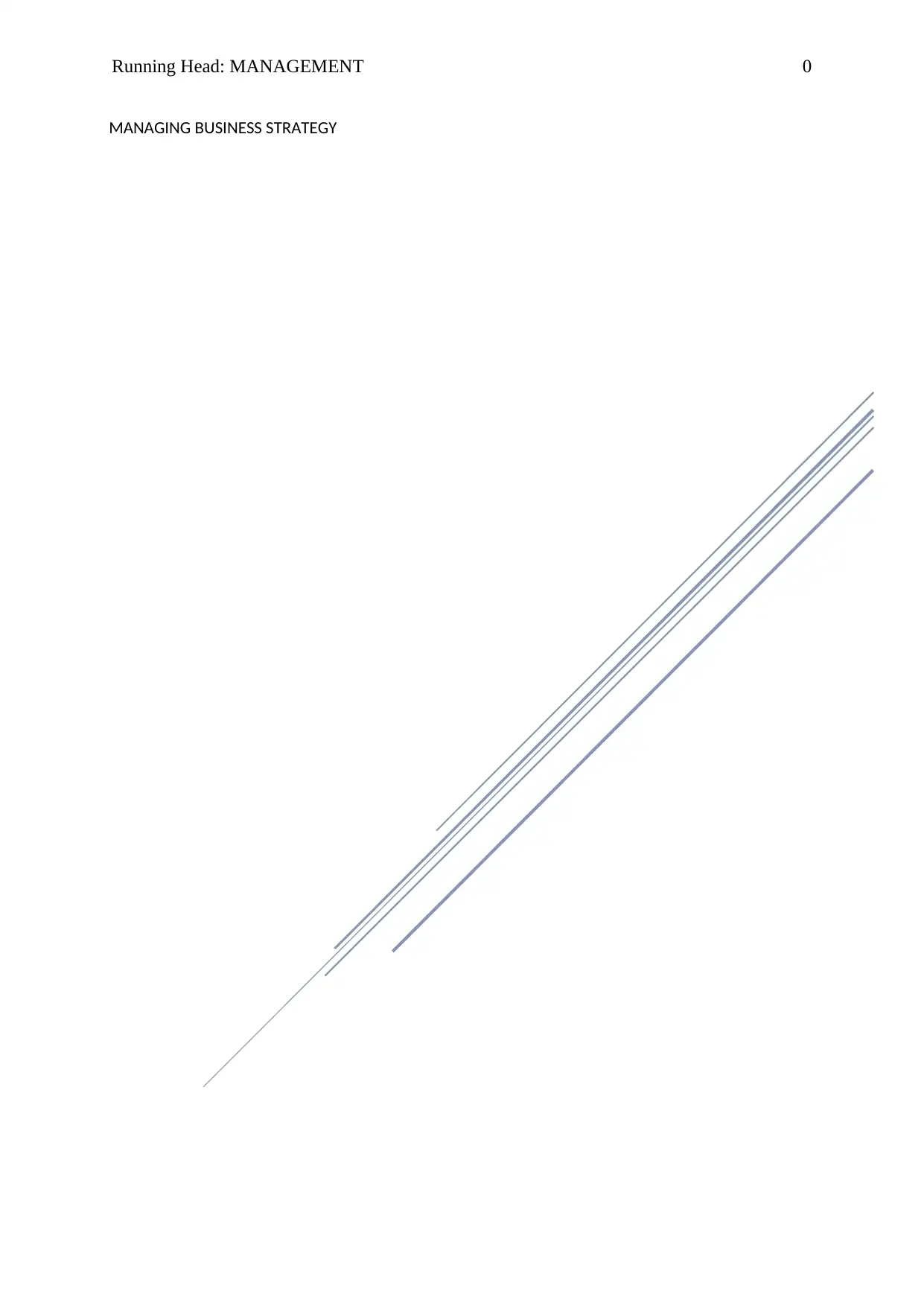
Running Head: MANAGEMENT 0
MANAGING BUSINESS STRATEGY
MANAGING BUSINESS STRATEGY
Paraphrase This Document
Need a fresh take? Get an instant paraphrase of this document with our AI Paraphraser
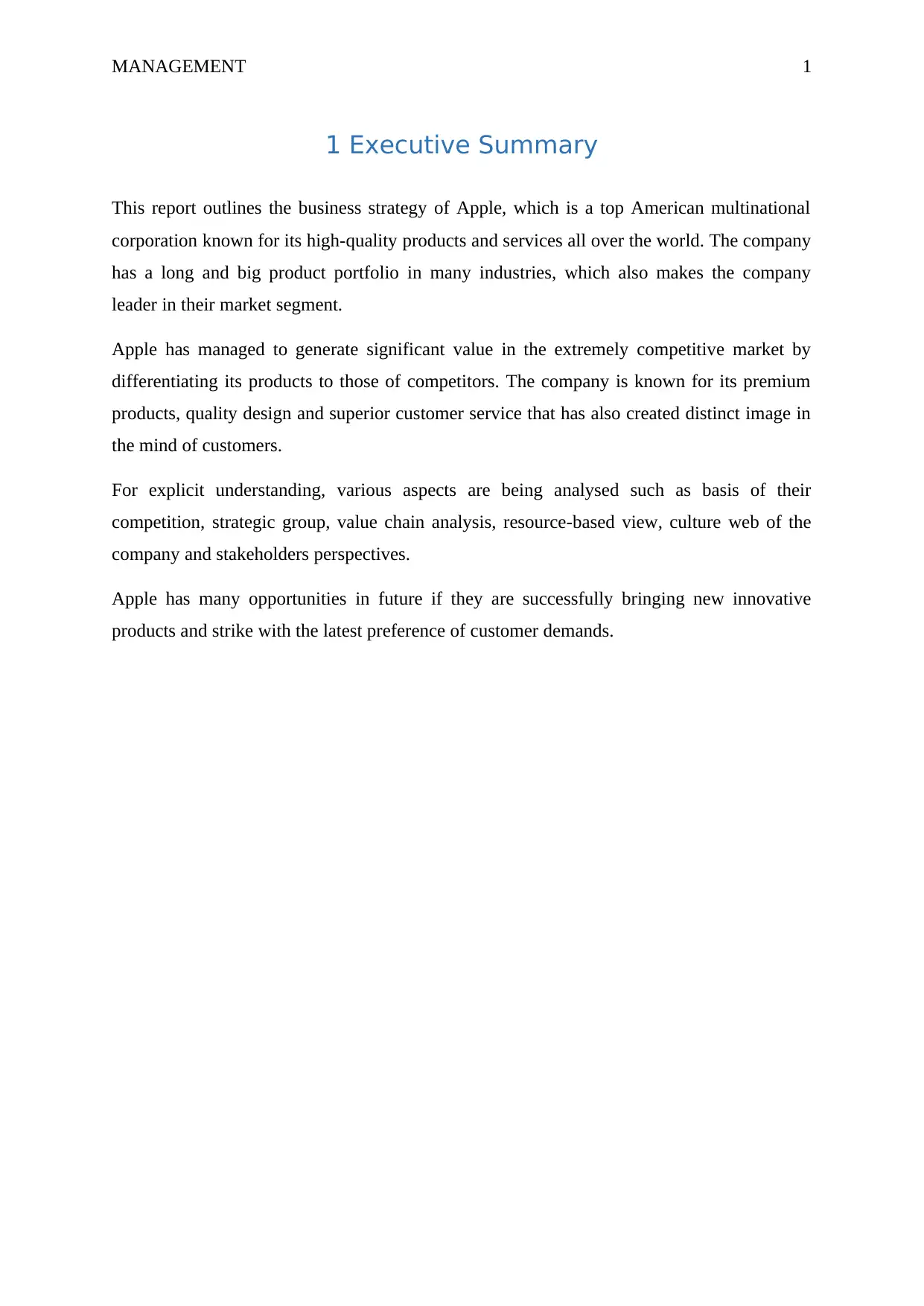
MANAGEMENT 1
1 Executive Summary
This report outlines the business strategy of Apple, which is a top American multinational
corporation known for its high-quality products and services all over the world. The company
has a long and big product portfolio in many industries, which also makes the company
leader in their market segment.
Apple has managed to generate significant value in the extremely competitive market by
differentiating its products to those of competitors. The company is known for its premium
products, quality design and superior customer service that has also created distinct image in
the mind of customers.
For explicit understanding, various aspects are being analysed such as basis of their
competition, strategic group, value chain analysis, resource-based view, culture web of the
company and stakeholders perspectives.
Apple has many opportunities in future if they are successfully bringing new innovative
products and strike with the latest preference of customer demands.
1 Executive Summary
This report outlines the business strategy of Apple, which is a top American multinational
corporation known for its high-quality products and services all over the world. The company
has a long and big product portfolio in many industries, which also makes the company
leader in their market segment.
Apple has managed to generate significant value in the extremely competitive market by
differentiating its products to those of competitors. The company is known for its premium
products, quality design and superior customer service that has also created distinct image in
the mind of customers.
For explicit understanding, various aspects are being analysed such as basis of their
competition, strategic group, value chain analysis, resource-based view, culture web of the
company and stakeholders perspectives.
Apple has many opportunities in future if they are successfully bringing new innovative
products and strike with the latest preference of customer demands.
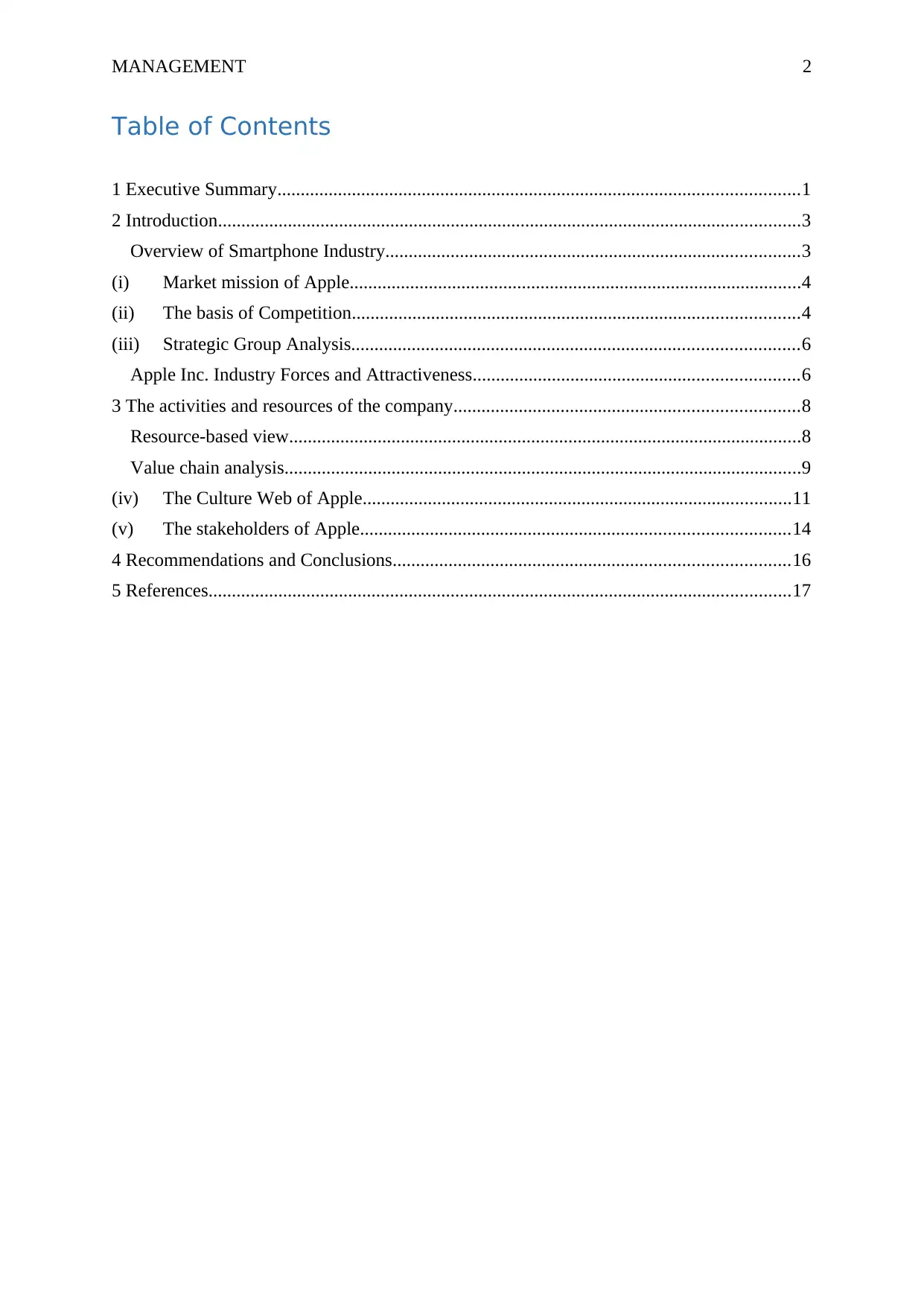
MANAGEMENT 2
Table of Contents
1 Executive Summary................................................................................................................1
2 Introduction.............................................................................................................................3
Overview of Smartphone Industry.........................................................................................3
(i) Market mission of Apple.................................................................................................4
(ii) The basis of Competition................................................................................................4
(iii) Strategic Group Analysis................................................................................................6
Apple Inc. Industry Forces and Attractiveness......................................................................6
3 The activities and resources of the company..........................................................................8
Resource-based view..............................................................................................................8
Value chain analysis...............................................................................................................9
(iv) The Culture Web of Apple............................................................................................11
(v) The stakeholders of Apple............................................................................................14
4 Recommendations and Conclusions.....................................................................................16
5 References.............................................................................................................................17
Table of Contents
1 Executive Summary................................................................................................................1
2 Introduction.............................................................................................................................3
Overview of Smartphone Industry.........................................................................................3
(i) Market mission of Apple.................................................................................................4
(ii) The basis of Competition................................................................................................4
(iii) Strategic Group Analysis................................................................................................6
Apple Inc. Industry Forces and Attractiveness......................................................................6
3 The activities and resources of the company..........................................................................8
Resource-based view..............................................................................................................8
Value chain analysis...............................................................................................................9
(iv) The Culture Web of Apple............................................................................................11
(v) The stakeholders of Apple............................................................................................14
4 Recommendations and Conclusions.....................................................................................16
5 References.............................................................................................................................17
⊘ This is a preview!⊘
Do you want full access?
Subscribe today to unlock all pages.

Trusted by 1+ million students worldwide
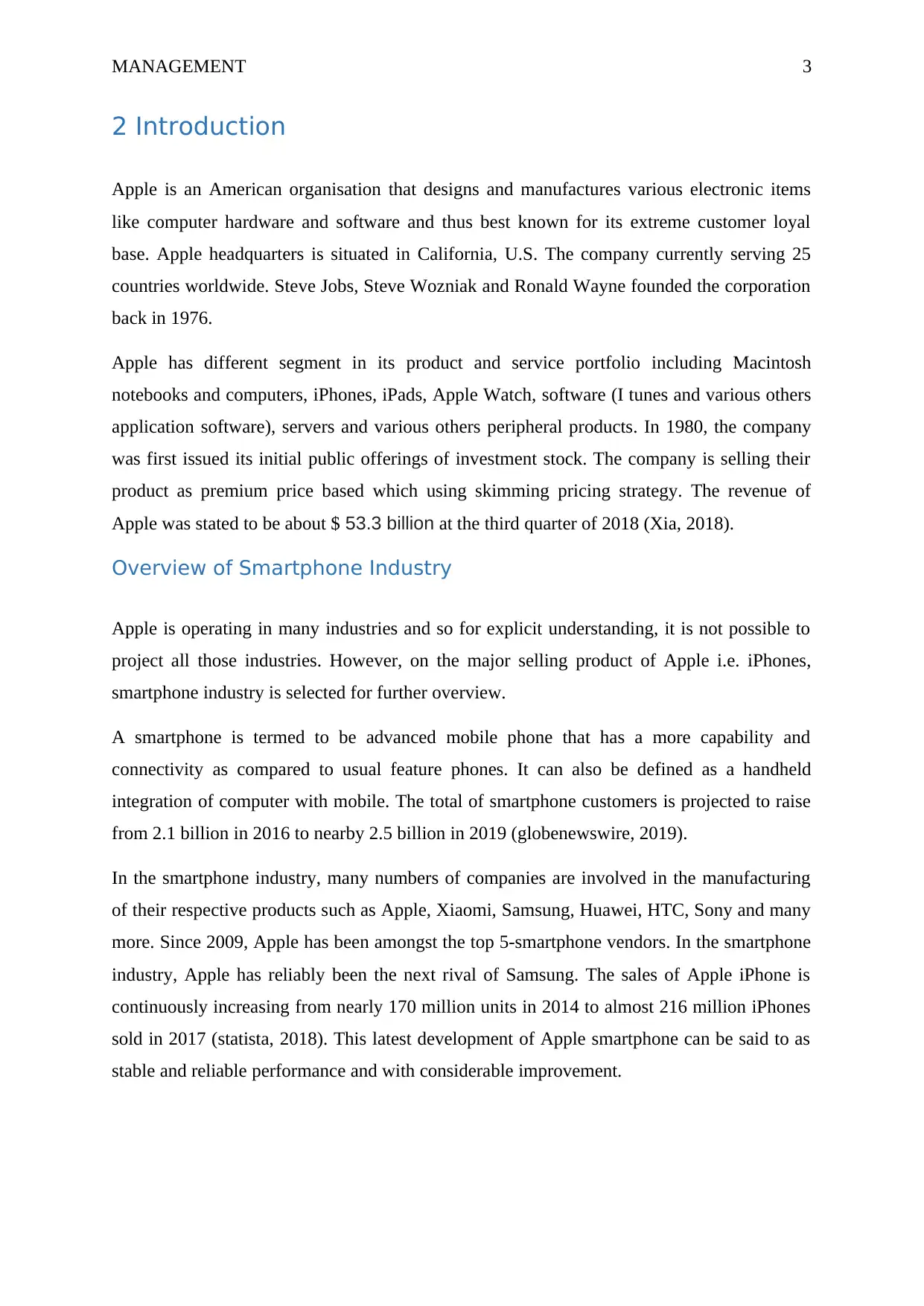
MANAGEMENT 3
2 Introduction
Apple is an American organisation that designs and manufactures various electronic items
like computer hardware and software and thus best known for its extreme customer loyal
base. Apple headquarters is situated in California, U.S. The company currently serving 25
countries worldwide. Steve Jobs, Steve Wozniak and Ronald Wayne founded the corporation
back in 1976.
Apple has different segment in its product and service portfolio including Macintosh
notebooks and computers, iPhones, iPads, Apple Watch, software (I tunes and various others
application software), servers and various others peripheral products. In 1980, the company
was first issued its initial public offerings of investment stock. The company is selling their
product as premium price based which using skimming pricing strategy. The revenue of
Apple was stated to be about $ 53.3 billion at the third quarter of 2018 (Xia, 2018).
Overview of Smartphone Industry
Apple is operating in many industries and so for explicit understanding, it is not possible to
project all those industries. However, on the major selling product of Apple i.e. iPhones,
smartphone industry is selected for further overview.
A smartphone is termed to be advanced mobile phone that has a more capability and
connectivity as compared to usual feature phones. It can also be defined as a handheld
integration of computer with mobile. The total of smartphone customers is projected to raise
from 2.1 billion in 2016 to nearby 2.5 billion in 2019 (globenewswire, 2019).
In the smartphone industry, many numbers of companies are involved in the manufacturing
of their respective products such as Apple, Xiaomi, Samsung, Huawei, HTC, Sony and many
more. Since 2009, Apple has been amongst the top 5-smartphone vendors. In the smartphone
industry, Apple has reliably been the next rival of Samsung. The sales of Apple iPhone is
continuously increasing from nearly 170 million units in 2014 to almost 216 million iPhones
sold in 2017 (statista, 2018). This latest development of Apple smartphone can be said to as
stable and reliable performance and with considerable improvement.
2 Introduction
Apple is an American organisation that designs and manufactures various electronic items
like computer hardware and software and thus best known for its extreme customer loyal
base. Apple headquarters is situated in California, U.S. The company currently serving 25
countries worldwide. Steve Jobs, Steve Wozniak and Ronald Wayne founded the corporation
back in 1976.
Apple has different segment in its product and service portfolio including Macintosh
notebooks and computers, iPhones, iPads, Apple Watch, software (I tunes and various others
application software), servers and various others peripheral products. In 1980, the company
was first issued its initial public offerings of investment stock. The company is selling their
product as premium price based which using skimming pricing strategy. The revenue of
Apple was stated to be about $ 53.3 billion at the third quarter of 2018 (Xia, 2018).
Overview of Smartphone Industry
Apple is operating in many industries and so for explicit understanding, it is not possible to
project all those industries. However, on the major selling product of Apple i.e. iPhones,
smartphone industry is selected for further overview.
A smartphone is termed to be advanced mobile phone that has a more capability and
connectivity as compared to usual feature phones. It can also be defined as a handheld
integration of computer with mobile. The total of smartphone customers is projected to raise
from 2.1 billion in 2016 to nearby 2.5 billion in 2019 (globenewswire, 2019).
In the smartphone industry, many numbers of companies are involved in the manufacturing
of their respective products such as Apple, Xiaomi, Samsung, Huawei, HTC, Sony and many
more. Since 2009, Apple has been amongst the top 5-smartphone vendors. In the smartphone
industry, Apple has reliably been the next rival of Samsung. The sales of Apple iPhone is
continuously increasing from nearly 170 million units in 2014 to almost 216 million iPhones
sold in 2017 (statista, 2018). This latest development of Apple smartphone can be said to as
stable and reliable performance and with considerable improvement.
Paraphrase This Document
Need a fresh take? Get an instant paraphrase of this document with our AI Paraphraser
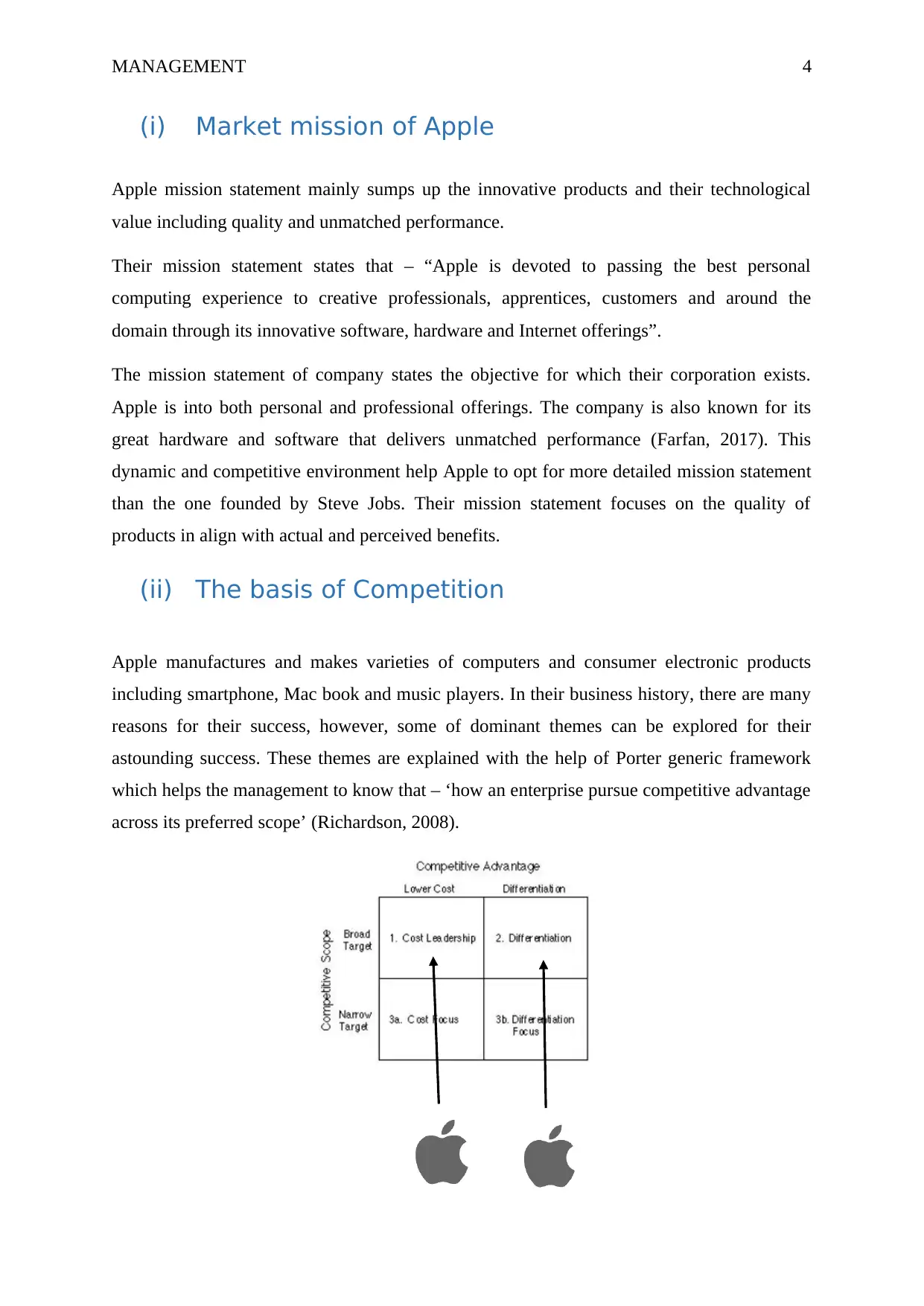
MANAGEMENT 4
(i) Market mission of Apple
Apple mission statement mainly sumps up the innovative products and their technological
value including quality and unmatched performance.
Their mission statement states that – “Apple is devoted to passing the best personal
computing experience to creative professionals, apprentices, customers and around the
domain through its innovative software, hardware and Internet offerings”.
The mission statement of company states the objective for which their corporation exists.
Apple is into both personal and professional offerings. The company is also known for its
great hardware and software that delivers unmatched performance (Farfan, 2017). This
dynamic and competitive environment help Apple to opt for more detailed mission statement
than the one founded by Steve Jobs. Their mission statement focuses on the quality of
products in align with actual and perceived benefits.
(ii) The basis of Competition
Apple manufactures and makes varieties of computers and consumer electronic products
including smartphone, Mac book and music players. In their business history, there are many
reasons for their success, however, some of dominant themes can be explored for their
astounding success. These themes are explained with the help of Porter generic framework
which helps the management to know that – ‘how an enterprise pursue competitive advantage
across its preferred scope’ (Richardson, 2008).
(i) Market mission of Apple
Apple mission statement mainly sumps up the innovative products and their technological
value including quality and unmatched performance.
Their mission statement states that – “Apple is devoted to passing the best personal
computing experience to creative professionals, apprentices, customers and around the
domain through its innovative software, hardware and Internet offerings”.
The mission statement of company states the objective for which their corporation exists.
Apple is into both personal and professional offerings. The company is also known for its
great hardware and software that delivers unmatched performance (Farfan, 2017). This
dynamic and competitive environment help Apple to opt for more detailed mission statement
than the one founded by Steve Jobs. Their mission statement focuses on the quality of
products in align with actual and perceived benefits.
(ii) The basis of Competition
Apple manufactures and makes varieties of computers and consumer electronic products
including smartphone, Mac book and music players. In their business history, there are many
reasons for their success, however, some of dominant themes can be explored for their
astounding success. These themes are explained with the help of Porter generic framework
which helps the management to know that – ‘how an enterprise pursue competitive advantage
across its preferred scope’ (Richardson, 2008).
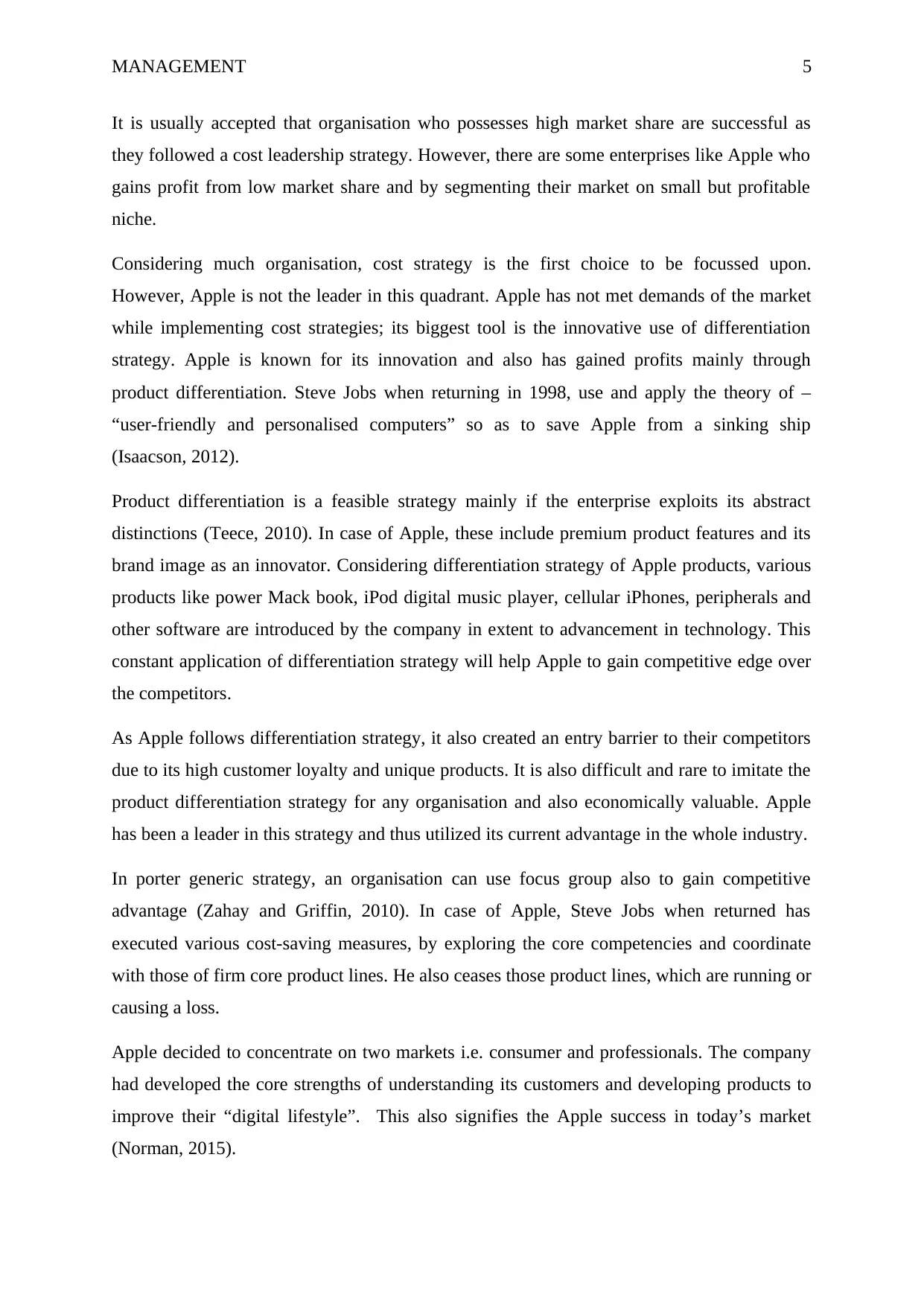
MANAGEMENT 5
It is usually accepted that organisation who possesses high market share are successful as
they followed a cost leadership strategy. However, there are some enterprises like Apple who
gains profit from low market share and by segmenting their market on small but profitable
niche.
Considering much organisation, cost strategy is the first choice to be focussed upon.
However, Apple is not the leader in this quadrant. Apple has not met demands of the market
while implementing cost strategies; its biggest tool is the innovative use of differentiation
strategy. Apple is known for its innovation and also has gained profits mainly through
product differentiation. Steve Jobs when returning in 1998, use and apply the theory of –
“user-friendly and personalised computers” so as to save Apple from a sinking ship
(Isaacson, 2012).
Product differentiation is a feasible strategy mainly if the enterprise exploits its abstract
distinctions (Teece, 2010). In case of Apple, these include premium product features and its
brand image as an innovator. Considering differentiation strategy of Apple products, various
products like power Mack book, iPod digital music player, cellular iPhones, peripherals and
other software are introduced by the company in extent to advancement in technology. This
constant application of differentiation strategy will help Apple to gain competitive edge over
the competitors.
As Apple follows differentiation strategy, it also created an entry barrier to their competitors
due to its high customer loyalty and unique products. It is also difficult and rare to imitate the
product differentiation strategy for any organisation and also economically valuable. Apple
has been a leader in this strategy and thus utilized its current advantage in the whole industry.
In porter generic strategy, an organisation can use focus group also to gain competitive
advantage (Zahay and Griffin, 2010). In case of Apple, Steve Jobs when returned has
executed various cost-saving measures, by exploring the core competencies and coordinate
with those of firm core product lines. He also ceases those product lines, which are running or
causing a loss.
Apple decided to concentrate on two markets i.e. consumer and professionals. The company
had developed the core strengths of understanding its customers and developing products to
improve their “digital lifestyle”. This also signifies the Apple success in today’s market
(Norman, 2015).
It is usually accepted that organisation who possesses high market share are successful as
they followed a cost leadership strategy. However, there are some enterprises like Apple who
gains profit from low market share and by segmenting their market on small but profitable
niche.
Considering much organisation, cost strategy is the first choice to be focussed upon.
However, Apple is not the leader in this quadrant. Apple has not met demands of the market
while implementing cost strategies; its biggest tool is the innovative use of differentiation
strategy. Apple is known for its innovation and also has gained profits mainly through
product differentiation. Steve Jobs when returning in 1998, use and apply the theory of –
“user-friendly and personalised computers” so as to save Apple from a sinking ship
(Isaacson, 2012).
Product differentiation is a feasible strategy mainly if the enterprise exploits its abstract
distinctions (Teece, 2010). In case of Apple, these include premium product features and its
brand image as an innovator. Considering differentiation strategy of Apple products, various
products like power Mack book, iPod digital music player, cellular iPhones, peripherals and
other software are introduced by the company in extent to advancement in technology. This
constant application of differentiation strategy will help Apple to gain competitive edge over
the competitors.
As Apple follows differentiation strategy, it also created an entry barrier to their competitors
due to its high customer loyalty and unique products. It is also difficult and rare to imitate the
product differentiation strategy for any organisation and also economically valuable. Apple
has been a leader in this strategy and thus utilized its current advantage in the whole industry.
In porter generic strategy, an organisation can use focus group also to gain competitive
advantage (Zahay and Griffin, 2010). In case of Apple, Steve Jobs when returned has
executed various cost-saving measures, by exploring the core competencies and coordinate
with those of firm core product lines. He also ceases those product lines, which are running or
causing a loss.
Apple decided to concentrate on two markets i.e. consumer and professionals. The company
had developed the core strengths of understanding its customers and developing products to
improve their “digital lifestyle”. This also signifies the Apple success in today’s market
(Norman, 2015).
⊘ This is a preview!⊘
Do you want full access?
Subscribe today to unlock all pages.

Trusted by 1+ million students worldwide
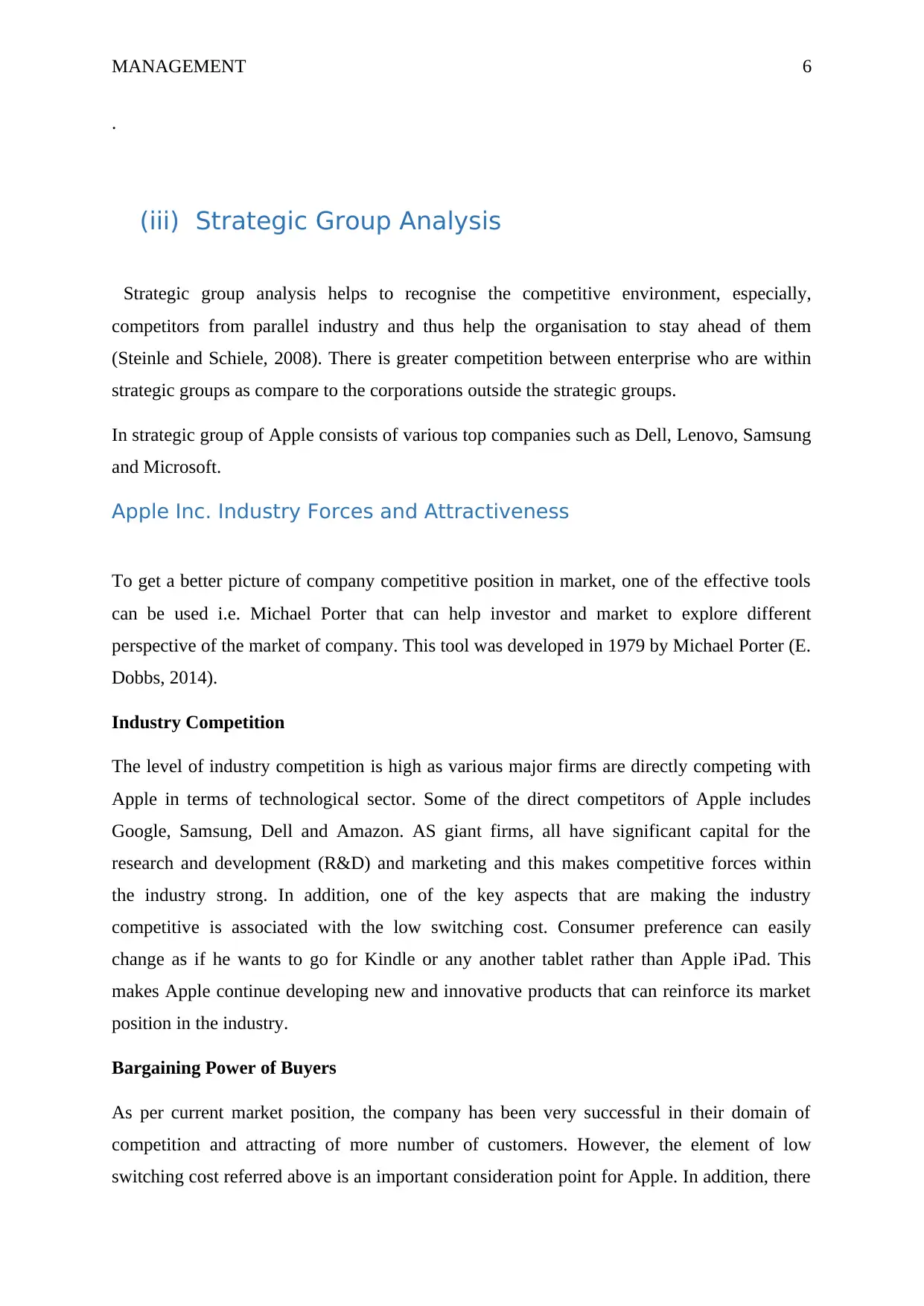
MANAGEMENT 6
.
(iii) Strategic Group Analysis
Strategic group analysis helps to recognise the competitive environment, especially,
competitors from parallel industry and thus help the organisation to stay ahead of them
(Steinle and Schiele, 2008). There is greater competition between enterprise who are within
strategic groups as compare to the corporations outside the strategic groups.
In strategic group of Apple consists of various top companies such as Dell, Lenovo, Samsung
and Microsoft.
Apple Inc. Industry Forces and Attractiveness
To get a better picture of company competitive position in market, one of the effective tools
can be used i.e. Michael Porter that can help investor and market to explore different
perspective of the market of company. This tool was developed in 1979 by Michael Porter (E.
Dobbs, 2014).
Industry Competition
The level of industry competition is high as various major firms are directly competing with
Apple in terms of technological sector. Some of the direct competitors of Apple includes
Google, Samsung, Dell and Amazon. AS giant firms, all have significant capital for the
research and development (R&D) and marketing and this makes competitive forces within
the industry strong. In addition, one of the key aspects that are making the industry
competitive is associated with the low switching cost. Consumer preference can easily
change as if he wants to go for Kindle or any another tablet rather than Apple iPad. This
makes Apple continue developing new and innovative products that can reinforce its market
position in the industry.
Bargaining Power of Buyers
As per current market position, the company has been very successful in their domain of
competition and attracting of more number of customers. However, the element of low
switching cost referred above is an important consideration point for Apple. In addition, there
.
(iii) Strategic Group Analysis
Strategic group analysis helps to recognise the competitive environment, especially,
competitors from parallel industry and thus help the organisation to stay ahead of them
(Steinle and Schiele, 2008). There is greater competition between enterprise who are within
strategic groups as compare to the corporations outside the strategic groups.
In strategic group of Apple consists of various top companies such as Dell, Lenovo, Samsung
and Microsoft.
Apple Inc. Industry Forces and Attractiveness
To get a better picture of company competitive position in market, one of the effective tools
can be used i.e. Michael Porter that can help investor and market to explore different
perspective of the market of company. This tool was developed in 1979 by Michael Porter (E.
Dobbs, 2014).
Industry Competition
The level of industry competition is high as various major firms are directly competing with
Apple in terms of technological sector. Some of the direct competitors of Apple includes
Google, Samsung, Dell and Amazon. AS giant firms, all have significant capital for the
research and development (R&D) and marketing and this makes competitive forces within
the industry strong. In addition, one of the key aspects that are making the industry
competitive is associated with the low switching cost. Consumer preference can easily
change as if he wants to go for Kindle or any another tablet rather than Apple iPad. This
makes Apple continue developing new and innovative products that can reinforce its market
position in the industry.
Bargaining Power of Buyers
As per current market position, the company has been very successful in their domain of
competition and attracting of more number of customers. However, the element of low
switching cost referred above is an important consideration point for Apple. In addition, there
Paraphrase This Document
Need a fresh take? Get an instant paraphrase of this document with our AI Paraphraser
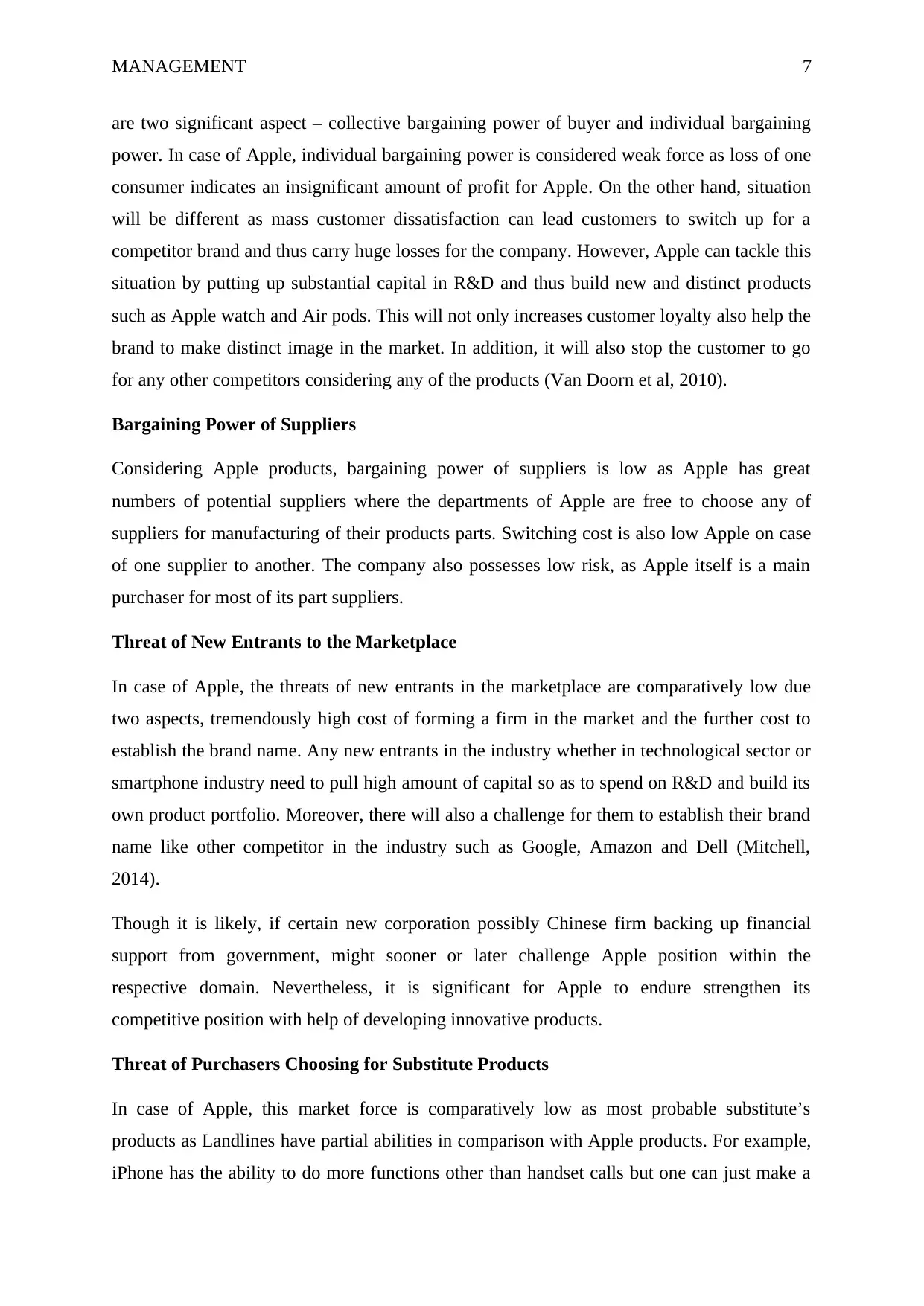
MANAGEMENT 7
are two significant aspect – collective bargaining power of buyer and individual bargaining
power. In case of Apple, individual bargaining power is considered weak force as loss of one
consumer indicates an insignificant amount of profit for Apple. On the other hand, situation
will be different as mass customer dissatisfaction can lead customers to switch up for a
competitor brand and thus carry huge losses for the company. However, Apple can tackle this
situation by putting up substantial capital in R&D and thus build new and distinct products
such as Apple watch and Air pods. This will not only increases customer loyalty also help the
brand to make distinct image in the market. In addition, it will also stop the customer to go
for any other competitors considering any of the products (Van Doorn et al, 2010).
Bargaining Power of Suppliers
Considering Apple products, bargaining power of suppliers is low as Apple has great
numbers of potential suppliers where the departments of Apple are free to choose any of
suppliers for manufacturing of their products parts. Switching cost is also low Apple on case
of one supplier to another. The company also possesses low risk, as Apple itself is a main
purchaser for most of its part suppliers.
Threat of New Entrants to the Marketplace
In case of Apple, the threats of new entrants in the marketplace are comparatively low due
two aspects, tremendously high cost of forming a firm in the market and the further cost to
establish the brand name. Any new entrants in the industry whether in technological sector or
smartphone industry need to pull high amount of capital so as to spend on R&D and build its
own product portfolio. Moreover, there will also a challenge for them to establish their brand
name like other competitor in the industry such as Google, Amazon and Dell (Mitchell,
2014).
Though it is likely, if certain new corporation possibly Chinese firm backing up financial
support from government, might sooner or later challenge Apple position within the
respective domain. Nevertheless, it is significant for Apple to endure strengthen its
competitive position with help of developing innovative products.
Threat of Purchasers Choosing for Substitute Products
In case of Apple, this market force is comparatively low as most probable substitute’s
products as Landlines have partial abilities in comparison with Apple products. For example,
iPhone has the ability to do more functions other than handset calls but one can just make a
are two significant aspect – collective bargaining power of buyer and individual bargaining
power. In case of Apple, individual bargaining power is considered weak force as loss of one
consumer indicates an insignificant amount of profit for Apple. On the other hand, situation
will be different as mass customer dissatisfaction can lead customers to switch up for a
competitor brand and thus carry huge losses for the company. However, Apple can tackle this
situation by putting up substantial capital in R&D and thus build new and distinct products
such as Apple watch and Air pods. This will not only increases customer loyalty also help the
brand to make distinct image in the market. In addition, it will also stop the customer to go
for any other competitors considering any of the products (Van Doorn et al, 2010).
Bargaining Power of Suppliers
Considering Apple products, bargaining power of suppliers is low as Apple has great
numbers of potential suppliers where the departments of Apple are free to choose any of
suppliers for manufacturing of their products parts. Switching cost is also low Apple on case
of one supplier to another. The company also possesses low risk, as Apple itself is a main
purchaser for most of its part suppliers.
Threat of New Entrants to the Marketplace
In case of Apple, the threats of new entrants in the marketplace are comparatively low due
two aspects, tremendously high cost of forming a firm in the market and the further cost to
establish the brand name. Any new entrants in the industry whether in technological sector or
smartphone industry need to pull high amount of capital so as to spend on R&D and build its
own product portfolio. Moreover, there will also a challenge for them to establish their brand
name like other competitor in the industry such as Google, Amazon and Dell (Mitchell,
2014).
Though it is likely, if certain new corporation possibly Chinese firm backing up financial
support from government, might sooner or later challenge Apple position within the
respective domain. Nevertheless, it is significant for Apple to endure strengthen its
competitive position with help of developing innovative products.
Threat of Purchasers Choosing for Substitute Products
In case of Apple, this market force is comparatively low as most probable substitute’s
products as Landlines have partial abilities in comparison with Apple products. For example,
iPhone has the ability to do more functions other than handset calls but one can just make a
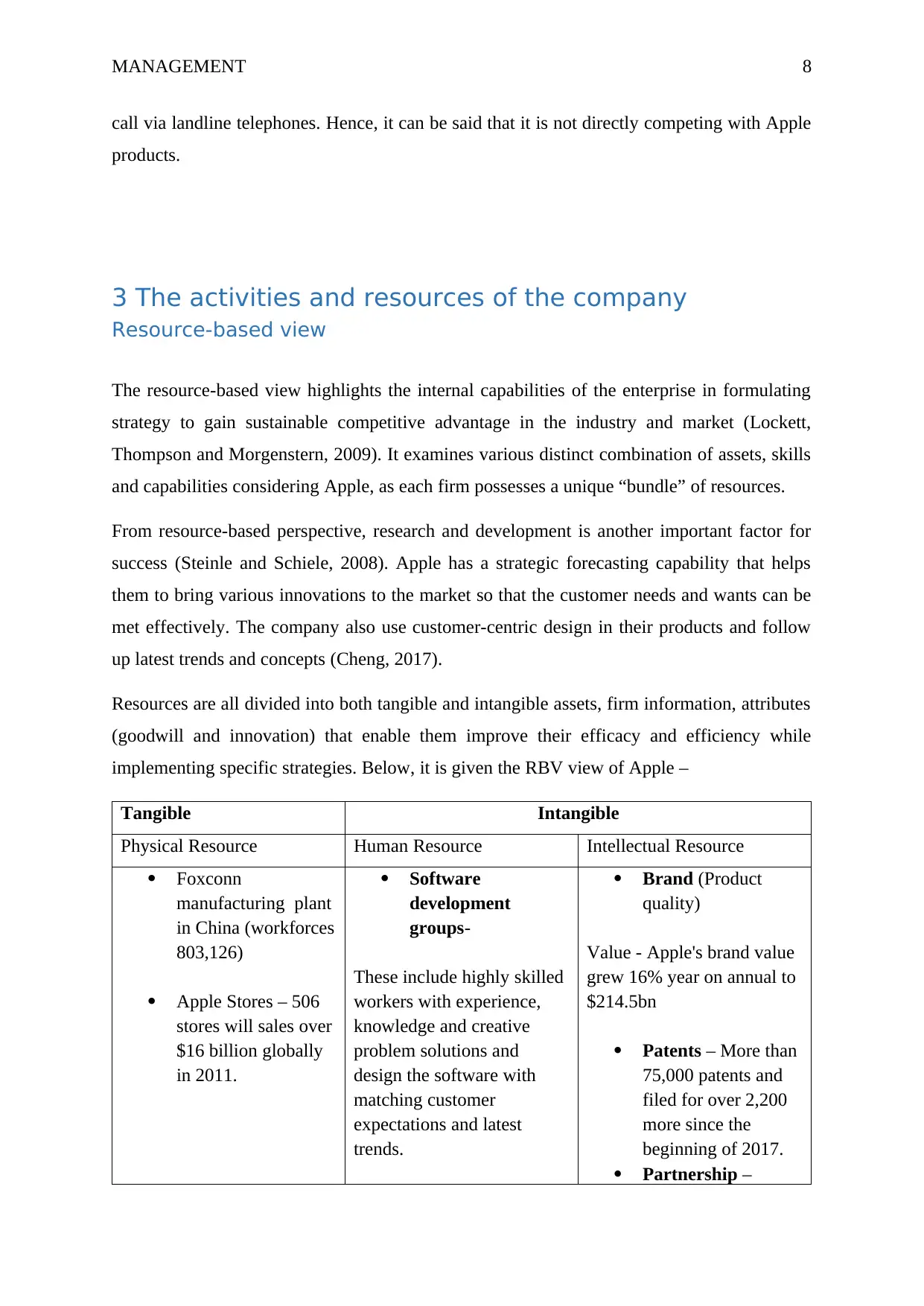
MANAGEMENT 8
call via landline telephones. Hence, it can be said that it is not directly competing with Apple
products.
3 The activities and resources of the company
Resource-based view
The resource-based view highlights the internal capabilities of the enterprise in formulating
strategy to gain sustainable competitive advantage in the industry and market (Lockett,
Thompson and Morgenstern, 2009). It examines various distinct combination of assets, skills
and capabilities considering Apple, as each firm possesses a unique “bundle” of resources.
From resource-based perspective, research and development is another important factor for
success (Steinle and Schiele, 2008). Apple has a strategic forecasting capability that helps
them to bring various innovations to the market so that the customer needs and wants can be
met effectively. The company also use customer-centric design in their products and follow
up latest trends and concepts (Cheng, 2017).
Resources are all divided into both tangible and intangible assets, firm information, attributes
(goodwill and innovation) that enable them improve their efficacy and efficiency while
implementing specific strategies. Below, it is given the RBV view of Apple –
Tangible Intangible
Physical Resource Human Resource Intellectual Resource
Foxconn
manufacturing plant
in China (workforces
803,126)
Apple Stores – 506
stores will sales over
$16 billion globally
in 2011.
Software
development
groups-
These include highly skilled
workers with experience,
knowledge and creative
problem solutions and
design the software with
matching customer
expectations and latest
trends.
Brand (Product
quality)
Value - Apple's brand value
grew 16% year on annual to
$214.5bn
Patents – More than
75,000 patents and
filed for over 2,200
more since the
beginning of 2017.
Partnership –
call via landline telephones. Hence, it can be said that it is not directly competing with Apple
products.
3 The activities and resources of the company
Resource-based view
The resource-based view highlights the internal capabilities of the enterprise in formulating
strategy to gain sustainable competitive advantage in the industry and market (Lockett,
Thompson and Morgenstern, 2009). It examines various distinct combination of assets, skills
and capabilities considering Apple, as each firm possesses a unique “bundle” of resources.
From resource-based perspective, research and development is another important factor for
success (Steinle and Schiele, 2008). Apple has a strategic forecasting capability that helps
them to bring various innovations to the market so that the customer needs and wants can be
met effectively. The company also use customer-centric design in their products and follow
up latest trends and concepts (Cheng, 2017).
Resources are all divided into both tangible and intangible assets, firm information, attributes
(goodwill and innovation) that enable them improve their efficacy and efficiency while
implementing specific strategies. Below, it is given the RBV view of Apple –
Tangible Intangible
Physical Resource Human Resource Intellectual Resource
Foxconn
manufacturing plant
in China (workforces
803,126)
Apple Stores – 506
stores will sales over
$16 billion globally
in 2011.
Software
development
groups-
These include highly skilled
workers with experience,
knowledge and creative
problem solutions and
design the software with
matching customer
expectations and latest
trends.
Brand (Product
quality)
Value - Apple's brand value
grew 16% year on annual to
$214.5bn
Patents – More than
75,000 patents and
filed for over 2,200
more since the
beginning of 2017.
Partnership –
⊘ This is a preview!⊘
Do you want full access?
Subscribe today to unlock all pages.

Trusted by 1+ million students worldwide
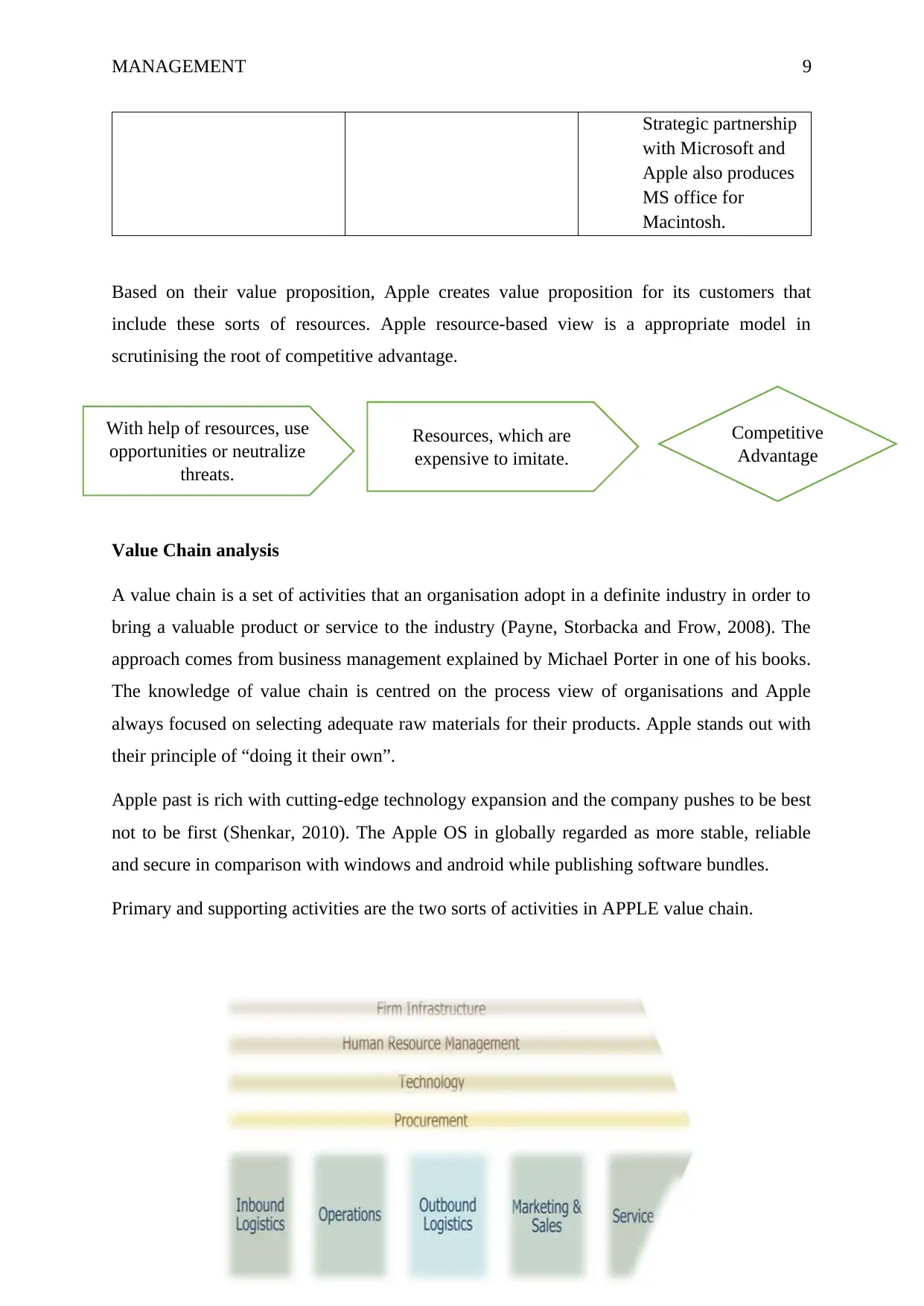
MANAGEMENT 9
Strategic partnership
with Microsoft and
Apple also produces
MS office for
Macintosh.
Based on their value proposition, Apple creates value proposition for its customers that
include these sorts of resources. Apple resource-based view is a appropriate model in
scrutinising the root of competitive advantage.
Value chain analysis
Value Chain analysis
A value chain is a set of activities that an organisation adopt in a definite industry in order to
bring a valuable product or service to the industry (Payne, Storbacka and Frow, 2008). The
approach comes from business management explained by Michael Porter in one of his books.
The knowledge of value chain is centred on the process view of organisations and Apple
always focused on selecting adequate raw materials for their products. Apple stands out with
their principle of “doing it their own”.
Apple past is rich with cutting-edge technology expansion and the company pushes to be best
not to be first (Shenkar, 2010). The Apple OS in globally regarded as more stable, reliable
and secure in comparison with windows and android while publishing software bundles.
Primary and supporting activities are the two sorts of activities in APPLE value chain.
With help of resources, use
opportunities or neutralize
threats.
Resources, which are
expensive to imitate.
Competitive
Advantage
Strategic partnership
with Microsoft and
Apple also produces
MS office for
Macintosh.
Based on their value proposition, Apple creates value proposition for its customers that
include these sorts of resources. Apple resource-based view is a appropriate model in
scrutinising the root of competitive advantage.
Value chain analysis
Value Chain analysis
A value chain is a set of activities that an organisation adopt in a definite industry in order to
bring a valuable product or service to the industry (Payne, Storbacka and Frow, 2008). The
approach comes from business management explained by Michael Porter in one of his books.
The knowledge of value chain is centred on the process view of organisations and Apple
always focused on selecting adequate raw materials for their products. Apple stands out with
their principle of “doing it their own”.
Apple past is rich with cutting-edge technology expansion and the company pushes to be best
not to be first (Shenkar, 2010). The Apple OS in globally regarded as more stable, reliable
and secure in comparison with windows and android while publishing software bundles.
Primary and supporting activities are the two sorts of activities in APPLE value chain.
With help of resources, use
opportunities or neutralize
threats.
Resources, which are
expensive to imitate.
Competitive
Advantage
Paraphrase This Document
Need a fresh take? Get an instant paraphrase of this document with our AI Paraphraser
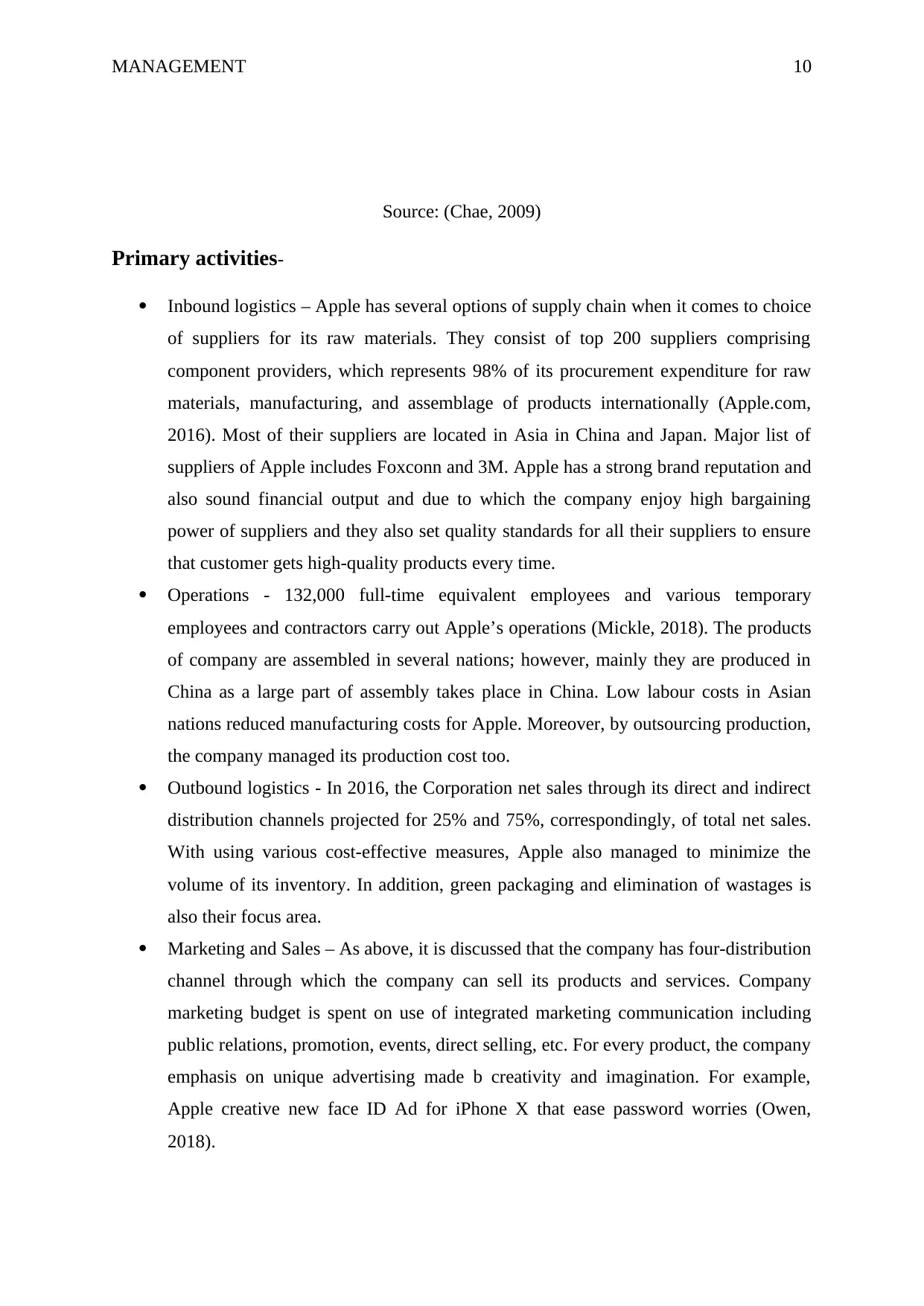
MANAGEMENT 10
Source: (Chae, 2009)
Primary activities-
Inbound logistics – Apple has several options of supply chain when it comes to choice
of suppliers for its raw materials. They consist of top 200 suppliers comprising
component providers, which represents 98% of its procurement expenditure for raw
materials, manufacturing, and assemblage of products internationally (Apple.com,
2016). Most of their suppliers are located in Asia in China and Japan. Major list of
suppliers of Apple includes Foxconn and 3M. Apple has a strong brand reputation and
also sound financial output and due to which the company enjoy high bargaining
power of suppliers and they also set quality standards for all their suppliers to ensure
that customer gets high-quality products every time.
Operations - 132,000 full-time equivalent employees and various temporary
employees and contractors carry out Apple’s operations (Mickle, 2018). The products
of company are assembled in several nations; however, mainly they are produced in
China as a large part of assembly takes place in China. Low labour costs in Asian
nations reduced manufacturing costs for Apple. Moreover, by outsourcing production,
the company managed its production cost too.
Outbound logistics - In 2016, the Corporation net sales through its direct and indirect
distribution channels projected for 25% and 75%, correspondingly, of total net sales.
With using various cost-effective measures, Apple also managed to minimize the
volume of its inventory. In addition, green packaging and elimination of wastages is
also their focus area.
Marketing and Sales – As above, it is discussed that the company has four-distribution
channel through which the company can sell its products and services. Company
marketing budget is spent on use of integrated marketing communication including
public relations, promotion, events, direct selling, etc. For every product, the company
emphasis on unique advertising made b creativity and imagination. For example,
Apple creative new face ID Ad for iPhone X that ease password worries (Owen,
2018).
Source: (Chae, 2009)
Primary activities-
Inbound logistics – Apple has several options of supply chain when it comes to choice
of suppliers for its raw materials. They consist of top 200 suppliers comprising
component providers, which represents 98% of its procurement expenditure for raw
materials, manufacturing, and assemblage of products internationally (Apple.com,
2016). Most of their suppliers are located in Asia in China and Japan. Major list of
suppliers of Apple includes Foxconn and 3M. Apple has a strong brand reputation and
also sound financial output and due to which the company enjoy high bargaining
power of suppliers and they also set quality standards for all their suppliers to ensure
that customer gets high-quality products every time.
Operations - 132,000 full-time equivalent employees and various temporary
employees and contractors carry out Apple’s operations (Mickle, 2018). The products
of company are assembled in several nations; however, mainly they are produced in
China as a large part of assembly takes place in China. Low labour costs in Asian
nations reduced manufacturing costs for Apple. Moreover, by outsourcing production,
the company managed its production cost too.
Outbound logistics - In 2016, the Corporation net sales through its direct and indirect
distribution channels projected for 25% and 75%, correspondingly, of total net sales.
With using various cost-effective measures, Apple also managed to minimize the
volume of its inventory. In addition, green packaging and elimination of wastages is
also their focus area.
Marketing and Sales – As above, it is discussed that the company has four-distribution
channel through which the company can sell its products and services. Company
marketing budget is spent on use of integrated marketing communication including
public relations, promotion, events, direct selling, etc. For every product, the company
emphasis on unique advertising made b creativity and imagination. For example,
Apple creative new face ID Ad for iPhone X that ease password worries (Owen,
2018).
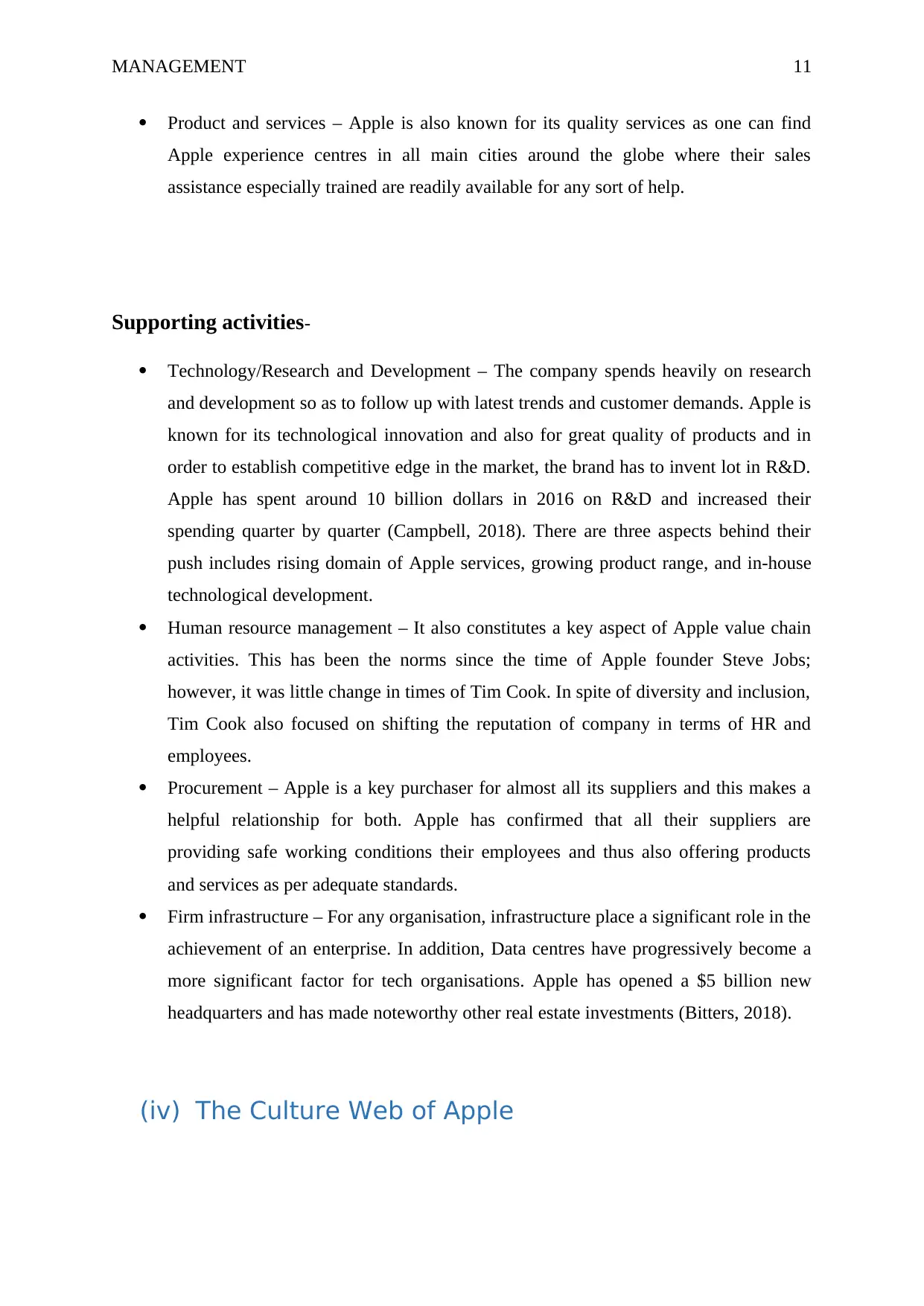
MANAGEMENT 11
Product and services – Apple is also known for its quality services as one can find
Apple experience centres in all main cities around the globe where their sales
assistance especially trained are readily available for any sort of help.
Supporting activities-
Technology/Research and Development – The company spends heavily on research
and development so as to follow up with latest trends and customer demands. Apple is
known for its technological innovation and also for great quality of products and in
order to establish competitive edge in the market, the brand has to invent lot in R&D.
Apple has spent around 10 billion dollars in 2016 on R&D and increased their
spending quarter by quarter (Campbell, 2018). There are three aspects behind their
push includes rising domain of Apple services, growing product range, and in-house
technological development.
Human resource management – It also constitutes a key aspect of Apple value chain
activities. This has been the norms since the time of Apple founder Steve Jobs;
however, it was little change in times of Tim Cook. In spite of diversity and inclusion,
Tim Cook also focused on shifting the reputation of company in terms of HR and
employees.
Procurement – Apple is a key purchaser for almost all its suppliers and this makes a
helpful relationship for both. Apple has confirmed that all their suppliers are
providing safe working conditions their employees and thus also offering products
and services as per adequate standards.
Firm infrastructure – For any organisation, infrastructure place a significant role in the
achievement of an enterprise. In addition, Data centres have progressively become a
more significant factor for tech organisations. Apple has opened a $5 billion new
headquarters and has made noteworthy other real estate investments (Bitters, 2018).
(iv) The Culture Web of Apple
Product and services – Apple is also known for its quality services as one can find
Apple experience centres in all main cities around the globe where their sales
assistance especially trained are readily available for any sort of help.
Supporting activities-
Technology/Research and Development – The company spends heavily on research
and development so as to follow up with latest trends and customer demands. Apple is
known for its technological innovation and also for great quality of products and in
order to establish competitive edge in the market, the brand has to invent lot in R&D.
Apple has spent around 10 billion dollars in 2016 on R&D and increased their
spending quarter by quarter (Campbell, 2018). There are three aspects behind their
push includes rising domain of Apple services, growing product range, and in-house
technological development.
Human resource management – It also constitutes a key aspect of Apple value chain
activities. This has been the norms since the time of Apple founder Steve Jobs;
however, it was little change in times of Tim Cook. In spite of diversity and inclusion,
Tim Cook also focused on shifting the reputation of company in terms of HR and
employees.
Procurement – Apple is a key purchaser for almost all its suppliers and this makes a
helpful relationship for both. Apple has confirmed that all their suppliers are
providing safe working conditions their employees and thus also offering products
and services as per adequate standards.
Firm infrastructure – For any organisation, infrastructure place a significant role in the
achievement of an enterprise. In addition, Data centres have progressively become a
more significant factor for tech organisations. Apple has opened a $5 billion new
headquarters and has made noteworthy other real estate investments (Bitters, 2018).
(iv) The Culture Web of Apple
⊘ This is a preview!⊘
Do you want full access?
Subscribe today to unlock all pages.

Trusted by 1+ million students worldwide
1 out of 21
Related Documents
Your All-in-One AI-Powered Toolkit for Academic Success.
+13062052269
info@desklib.com
Available 24*7 on WhatsApp / Email
![[object Object]](/_next/static/media/star-bottom.7253800d.svg)
Unlock your academic potential
Copyright © 2020–2025 A2Z Services. All Rights Reserved. Developed and managed by ZUCOL.





